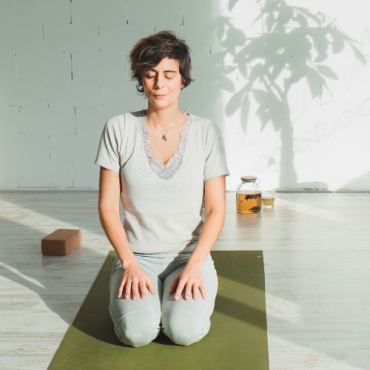by Cristina Guerra
The term “Yoga Nidra” simply means “yogic sleep”, in the way that it is a “conscious sleep”.
During regular sleep, the brain gets into the realms of the unconscious mind and awareness is not present. In a Yogic sleep the Yogi gets into a restful body and mind-state but remains aware of what is happening in the unconscious realm and surroundings. In this way, Nidra is a systematic method of inducing complete physical, mental and emotional relaxation.
The following blog article is part of the syllabus of the Yoga Nidra teacher training at Tula.

Nidra is not the practice itself; it is the state of pure being. Many will ask if that can be achieved in meditation or hypnosis. But Nidra is not meditation, because in meditation the brainwaves registered correspond to relaxation states with glimpses to the subconscious, and these are just at the moments when one achieves Samadhi or enlightenment. And Nidra is not hypnosis, since one is not aware during hypnosis and the brainwaves registered correspond to a deep sleep-sate with access to the unconscious mind.
Effortless state of being
Nidra is an effortless state of being with awareness with all that exists within, from past to future to other layers of existence. Nidra is an ancient tantric practice of dance between our subconscious and unconscious mind in pure awareness. And part of the Nidra practice is to bring the experience to the conscious state, because that is the way one is finally expanding awareness, to bring it into your waking daily life.
We are not used to travelling with awareness through all we have stored in our subconscious, and even less so in our unconscious – because we only have access to the unconscious when we are sleeping, and when we are sleeping we are not aware. We may have glimpses of access to the subconscious mind when we have achieved enlightenment in meditation or when we have a eureka moment for example, but it’s only a brief access to the subconscious.
The mind of the consciousness
So, what occurs when we are getting into Nidra is that we disconnect the body senses, while maintaining awareness. The body is sleeping but the mind is active, and it’s not that mind of the list-maker or over-thinker, it’s the mind of the consciousness. Whatever happens while going down between subconscious and unconscious is difficult to time, because memories and archetypes rush up and they can come from all different areas, from the past, from the future, from other layers of experience. And this is what makes the Nidra practice to be that experience of timelessness so many people describe, the same that happens in dreams, because dreams are this same dance between the subconscious and unconscious mind. But in dreams you are asleep, you are not aware and it makes it more difficult to reconnect them to reality.
Along the same lines, when we travel in between different states of consciousness the space that exists between experience changes. In psychology we have the term liminality, because you travel in between and beyond the limits or the edges of each state, in terms of brainwaves and in terms of consciousness, the same way as in the dreams. When we try to describe a dream, it all seems messy and nonsensical, due to these liminal spaces where everything is possible. There is no time and space when we get into deeper levels of consciousness, and besides measuring brainwaves when we are in this experience it’s difficult to define what derives from the subconscious or unconscious. However, from sharing experiences we come to the conclusion that a lot of times this sense of liminality happens during the change from one state to another too.
The Nidra state adapts to wherever you need to go
When we get into deeper conscious levels we are traveling into all the areas of the storage that have to be organized. So what happens there is out of our mind’s control, and it is important for that to happen, because if we use our thinking mind to organize it it’s going to give priorities that are not really the real priorities deep down. The one that rearranges it all is the unconscious mind, our deeper, wild pure knowledge knows better what to do with the chaos that our awakening mind creates. So when we get into Nidra we trust our unconscious, our inner knower, which knows where to take us. And in this way the Nidra practice is what we call in psychology an adaptogenic practice. It adapts to whatever has to be cleansed at the moment one is practicing, and that may be different today or tomorrow due to whatever happens during your day. One can be practicing a guided Nidra and describe something totally different from the script, or not be aware of where the session went, or that they simply fall asleep. All of the journeys are valuable, because the Nidra state just adapts the practice to wherever we need to go.
The master
It is essential to acknowledge that esoteric traditions passed through yoga practices from disciple to disciple. As many yoga books say, “this practice is to kept secret”. This is not just a selfish attachment to practices being hidden, it relates to the practices that require master supervision, because they can bring attendant damage if not applied correctly or in effort. The master knows the disciple so they know his or her limitations and obstacles; the master is a guide who helps the disciple to evolve spiritually. You are your own guru, but the master knows the technique, and evolution is a constant balance between going deeper through yourself and asking for help in the right moment. This is the case for even the most powerful techniques, the ones that can heal and take to paranormal abilities can at the same time cause damage to physical, mental and psychological being. Again, it all comes down to the balance, everything that has the power to create has the power to destroy. It was the responsibility of the master to safeguard the techniques, to instruct the disciple correctly and encourage those engaged in their use to do so morally and ethically with themselves.
Becoming the master
Every year Tula offers a 60-hrs. teacher training to train people to become a Yoga Nidra teacher. In a small group you are guided by lead trainer Cristina Guerra through the different structures of Nidra and you will learn how to teach them in a safe and correct manner. If you like to participate, or read more about the training, you can follow the link below to the Yoga Nidra teacher training page. You don’t need to be a yoga teacher to join the training. We usually have a wonderful mix of yogi’s, yoga teachers, therapist and even social workers.
Read further at the Yoga Nidra teacher training page »
About Cristina Guerra
 Cristina Guerra is a professional yoga and meditation instructor currently based in Portugal. Cristina has for the past years hosted classes and workshops in yoga and meditation across Southeast Asia, the Middle East, Europe and Australia.
Cristina Guerra is a professional yoga and meditation instructor currently based in Portugal. Cristina has for the past years hosted classes and workshops in yoga and meditation across Southeast Asia, the Middle East, Europe and Australia.
Before moving back to Portugal Cristina was a beloved teacher at Tula with weekly classes in Yoga Nidra and Restorative yoga. In 2018 we started with the first Yoga Nidra teacher training at Tula, which resulted in a group of incredible new Yoga Nidra teachers. Since then Cristina teaches a small group of enthusiasts the magical practice of Nidra every year. She travels back to Tula especially for delivering this training. Something we’re enormously grateful for.
You can read more about Cristina on her own website » sarvangaflow.com






Add Comment